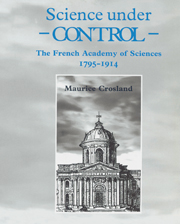Book contents
- Frontmatter
- Contents
- List of tables and figures
- Preface
- List of abbreviations
- INTRODUCTION
- 1 SCIENCE IN FRANCE
- 2 THE STRUCTURE OF THE ACADEMY
- 3 THE FUNCTIONING OF THE ACADEMY: SOME POSSIBLE ROLES
- 4 SCIENCE DIVIDED: THE SECTIONS
- 5 THE ACADEMICIANS
- 6 ELECTIONS: ‘GREEN FEVER’
- 7 REGISTRATION, JUDGEMENT AND REWARD
- 8 THE PRINTED WORD
- 9 AN ACADEMY UNDER GOVERNMENT CONTROL
- 10 ‘OUTSIDERS’: THE SCIENTIFIC FRINGE AND THE PUBLIC
- 11 THE INTERNATIONAL DIMENSION
- 12 THE CONTROL OF THE ACADEMY AND OF SCIENCE
- Name index
- Subject index
4 - SCIENCE DIVIDED: THE SECTIONS
Published online by Cambridge University Press: 09 October 2009
- Frontmatter
- Contents
- List of tables and figures
- Preface
- List of abbreviations
- INTRODUCTION
- 1 SCIENCE IN FRANCE
- 2 THE STRUCTURE OF THE ACADEMY
- 3 THE FUNCTIONING OF THE ACADEMY: SOME POSSIBLE ROLES
- 4 SCIENCE DIVIDED: THE SECTIONS
- 5 THE ACADEMICIANS
- 6 ELECTIONS: ‘GREEN FEVER’
- 7 REGISTRATION, JUDGEMENT AND REWARD
- 8 THE PRINTED WORD
- 9 AN ACADEMY UNDER GOVERNMENT CONTROL
- 10 ‘OUTSIDERS’: THE SCIENTIFIC FRINGE AND THE PUBLIC
- 11 THE INTERNATIONAL DIMENSION
- 12 THE CONTROL OF THE ACADEMY AND OF SCIENCE
- Name index
- Subject index
Summary
The main feature of the constitution of the Academy of Sciences consists of being composed exclusively of specialists, devoted entirely to the separate cultivation of the different sub-divisions of natural philosophy.
(August Comte, Correspondence générale, 1836, p. 264.)…eleven permanent divisions or little academies, each sovereign within its own sphere…
(M. Berthelot, ‘L'Académie des Sciences’ (1867), Science et philosophie, 1886, p. 209.)In an assembly of professors and savants, when some financial grant is made to a laboratory, at once all the other colleagues protest noisily. I do not think that an example to the contrary can be cited. Suppose that 3000 francs or so is given to a laboratory of Inorganic Chemistry. Well! What about Organic Chemistry? And Physiology? And Botany? And Zoology? And Physics? And Mechanics? And Geology? Jealous claims like these are after all legitimate. The zoologist feels he has a mission to defend Zoology; the botanist, to defend Botany. They have faith in their science; they do not wish it treated as a negligible quantity.
(Charles Richet, The natural history of a savant, 1923, trans. 1927, chap. 2, p. 20.)Defining science
The Academy of Sciences and its predecessor, the First Class of the National Institute, constituted a powerful force in defining science in the postrevolutionary era, which in the traditional division of French history constitutes the period marking the beginning of the modern world. Yet in some ways the First Class perpetuated ideas clearly established in the former Royal Academy.
- Type
- Chapter
- Information
- Science under ControlThe French Academy of Sciences 1795–1914, pp. 124 - 166Publisher: Cambridge University PressPrint publication year: 1992

